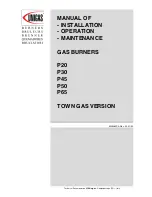
PART I: INSTALLATION
11
MOUNTINGS AND CONNECTIONS
Packing
The burners are dispatched in cardboard pakages with dimensions:
P20 - P30
98 x 55 x 46
(W x H x D)
P45 - P50
118 x 67 x 57
(W x H x D)
P65
127 x 84 x 76
(W x H x D)
Packing cases of this kind are affected by humidity and are not suitable for stacking. The following are placed in each packing
case.
1
burner with detached gas train (but electrically connected to the burner in DN65 models);
1
gasket to be inserted between the burner and the boiler;
1
envelope containing this manual .
To get rid of the burner’s packing and in the event of scrapping of the latter, follow the procedures laid down by current laws on
disposal of materials.
Unpacking the burner take care of not to damage the electrical connection between the burner and the gas train
(only on DN65 models).
Fitting the burner to the boiler
After fitting the burner to the boiler ensure that the space between the blast
tube and the refractory lining is sealed with appropriate insulating material
(ceramic fibre cord or refractory cement).
Key
1 Burner
2 Fixing nut
3 Washer
4 Seal
5 Stud bolt
6 Sightglass cleaning tube
7 Blast tube
Fig. 17
Matching the burner to the boiler
The burners described in this manual have been tested with combustion chambers that comply with EN676 regulation and
whose dimensions are described in the diagram in Fig. 18. In case the burner must be coupled with boilers with a combustion
chamber smaller in diameter or shorter than those described in the diagram, please contact the supplier, to verify that a correct
matching is possible, with respect of the application involved.
To correctly match the burner to the boiler verify the necessary input and the pressure in combustion chamber are included in
the burner performance curve; otherwise the choice of the burner must be revised consulting the burner manufacturer.
To choose the blast tube lenght follow the instructions of the boiler manufacturer. In absence of these consider the following:
!
Cast-iron boilers, three pass flue boilers (with the first pass in the rear part): the blast tube must protrude no more than 100
mm into the combustion chamber.
The length of the blast tubes does not always allow this requirement to be met, and thus it may be necessary to use a suitably-
sized spacer to move the burner backwards.
!
Pressurised boilers with flame reversal: in this case the blast tube must penetrate at least 50 - 100 mm into combustion
chamber in respect to the tube bundle plate.
Fig. 18
Firing intensity, diameter and lenght of the test flame
tube as a function of the heat input Q.
Key
a) Heat input Q in kW
b) Lenght of the flame tube in metres
c) Flame tube firing intensity in kW/m
3
d) Diameter of combustion chamber (m)
Summary of Contents for P20
Page 30: ...PART II OPERATION 30 Electrical diagram code 18 020 Burners P45 C TN C AB C PR ...
Page 32: ...PART II OPERATION 32 Electrical diagram code 04 622 Burners P20 P30 C MD ...
Page 33: ...PART II OPERATION 33 Electrical diagram 04 642 Burners P45 C MD ...
Page 34: ...PART II OPERATION 34 Electrical diagram code 05 615 Burner P65 C MD ...
Page 35: ...PART II OPERATION 35 SPARE PARTS ...
Page 36: ...PART II OPERATION 36 SPARE PARTS Burners P20 P30 C TN C AB ...
Page 38: ...PART II OPERATION 38 SPARE PARTS Burners P45 C TN C AB P50 C TN P65 C AB ...
Page 40: ...PART II OPERATION 40 SPARE PARTS Burners P20 P30 C MD ...
Page 42: ...PART II OPERATION 42 SPARE PARTS Burners P45 P65 C MD ...
Page 52: ......












































